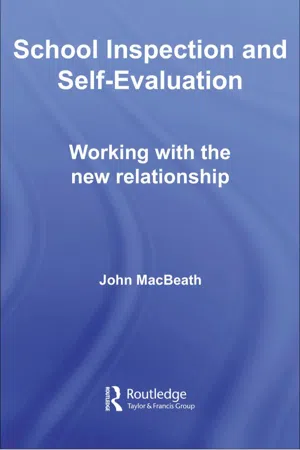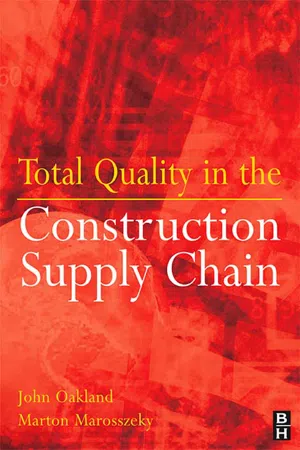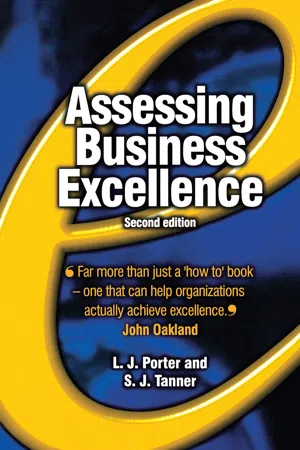Business
Self-Evaluation
Self-evaluation in business refers to the process of assessing one's own performance, strengths, weaknesses, and areas for improvement. It involves reflecting on one's actions, decisions, and outcomes to gain insights and make necessary adjustments. Self-evaluation is a valuable tool for personal and professional development, as it can lead to increased self-awareness and effectiveness in the workplace.
Written by Perlego with AI-assistance
Related key terms
Related key terms
1 of 4
Related key terms
1 of 3
3 Key excerpts on "Self-Evaluation"
- eBook - ePub
School Inspection & Self-Evaluation
Working with the New Relationship
- John Macbeath(Author)
- 2006(Publication Date)
- Routledge(Publisher)
6 Self-Evaluation, review, audit, self-assessment and self-inspectionCaminante no hay camino, se hace camino al andar Traveller, there is no path, you make the path as you walkThere is a plethora of terms for Self-Evaluation. Many describe the same things under a different name. However, often different terms refer to the same thing. This chapter teases out some of the important distinctions among common terminology, raising questions as to differing claims and outlines the seven key elements of Self-Evaluation.Self-Evaluation is a process of discovery rather than a tedious adherence to a well-trodden trail. Yet, as we have seen from surveys and research of what happens on the ground, the path is clearly marked out milestone by milestone for the weary traveller and is less a voyage of discovery than an impatient dash to the destination.Self-Evaluation has had a chequered history in British education. In the last half century it has been embraced, discarded and re-invented. It has, however, never gone away because it rests on an unassailable logic. As individuals, as groups, as organisations if we are blind to our faults and ignorant of our strengths we are unlikely to grow. There is a cartoon of an ugly ducking gazing at its own reflection in a pond and seeing an elegant swan. This may be the promise of things to come or it may simply be self-delusion. ‘Know thyself’, the counsel of the Oracle at Delphi was prescribed as the antidote to self-delusion and became the byword and underpinning philosophy of the Scottish approach to Self-Evaluation which has grown steadily from its first tentative piloting in 1989.Previous incarnations of Self-Evaluation enjoyed a brief life because, as Brian Fidler comments in reference to a previous set of protocols known as GRIDS,1 teachers were ‘better at identifying improvement rather than bringing about improvement’. GRIDS and other forms of Self-Evaluation took a back seat as a new inspection regime in the early 1990s raised the profile of external evaluation. There was, within the government, an impatience with Self-Evaluation. It was seen as too soft, too complacent and too much in the hands of the profession. It needed the much firmer and more objective hand of an external inspectorate. It was to take a change of government in 1997 before Self-Evaluation was reborn and forced on a reluctant Chief Inspector.2 - eBook - ePub
- John S Oakland, Marton Marosszeky(Authors)
- 2006(Publication Date)
- Routledge(Publisher)
The systematic measurement and review of operations is one of the most important management activities of any organization. Self-assessment, audit and review should lead to clearly discerned strengths and areas for improvement by focusing on the relationship between the people, processes, and performance. Within any successful organization these will be regular activities.Chapter highlights
Frameworks for self-assessmentMany organizations are turning to total quality models to measure and improve performance. Thee frameworks, including the Japanese Deming Prize, the US Baldrige Award and in Europe the EFQM Excellence Model.The nine components of the Excellence Model are: leadership, policy and strategy partnerships, people, resources, and processes (ENABLERS), customer results, people results, society results, and key performance results (RESULTS).The various award criteria provide rational bases against which to measure progress towards TQM in organizations. Self-assessment against, for example, the EFQM Excellence Model should be a regular activity, as it identifies opportunities for improvement in performance through processes and people.Methodologies for self-assessmentSelf-assessment against the Excellence Model may be performed using RADAR: results, approach, deployment, assessment and review.There are a number of approaches for self-assessment, including groups/workshops, surveys, pro-formas, matrices, award simulations, activity/process audits or hybrid approaches.Securing prevention by audit and review of the management systems - eBook - ePub
- Les Porter, Steve Tanner(Authors)
- 2012(Publication Date)
- Routledge(Publisher)
For example, the Myers–Briggs Type Indicator (MBTI) enables people to develop a better understanding of their own motivations, strengths and potential areas for growth, as well as facilitating a better understanding of other people. In particular, the MBTI attempts to describe how people take in information and how they organize the information and come to a conclusion. This is central to the assessment process. The use of an instrument such as the MBTI may help to form and develop more effective assessor teams. Simply taking a group of trained assessors does not automatically lead to an effective team. The team dynamics can be very complex.9.4 Collecting the Information
Self-assessment is an organizational health check based on a comprehensive internal assessment of organizational activities and their performance, and stakeholder perception. It involves assessing what an organization does and what it achieves. Many organizations are awash with data, which unfortunately is not always used effectively. Similarly, organizations usually have procedures explaining what they do in their main operational areas. A critical part of self-assessment involves making what is done and achieved match with what the criteria are asking for. The questions posed at criterion and sub-criterion level are designed to provide insights into organizational capability and performance, and it is therefore very important that organizations thoroughly understand the criteria before embarking upon the information-gathering phase.The information requirements will be largely determined by the self-assessment approach taken. For this discussion we will assume that an award-type process is being used, although in Chapter 10 we will consider other approaches to self-assessment. In the award-type process, there is a requirement to produce a position statement, not exceeding 75 pages, that explains what the organization does and what it achieves. This submission is the basis for a fact-based assessment (see Chapter 12
Index pages curate the most relevant extracts from our library of academic textbooks. They’ve been created using an in-house natural language model (NLM), each adding context and meaning to key research topics.
Explore more topic indexes
Explore more topic indexes
1 of 6
Explore more topic indexes
1 of 4


